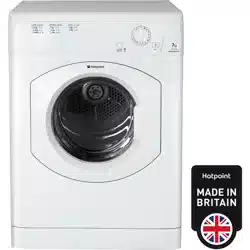Documents: Go to download!
User Manual
- User Manual - (English)
- Product Fiche - (English)
- Product Data Sheet - (English)
- Energy label - (English)
- INSTALLATION WHERE TO PUT YOUR DRYER
- VENTING
- ELECTRICAL CONNECTIONS
- LEVELLING YOUR DRYER
- BEFORE YOU START USING YOUR DRYER
- Dryer Description
- Laundry
- Troubleshooting
- Warnings
- GENERAL SAFETY
- INFORMATION ON RECYCLING AND DISPOSAL
- SAVE ENERGY AND RESPECT THE ENVIRONMENT
- OUR ADVISORS WILL REQUIRE THE FOLLOWING INFORMATION:
Table of contents
User Manual DRYER
INSTALLATION WHERE TO PUT YOUR DRYER
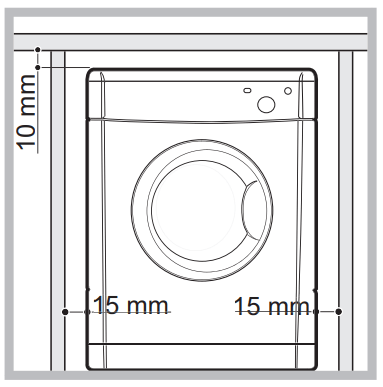
If you are going to install the appliance under a work counter be sure to leave a 10mm space between the top and any other objects on or above the machine and a 15mm space between the sides and any kitchen units or walls to ensure proper air circulation. The dryer must never be installed behind a lockable door, a sliding door or a door with a hinge on the opposite side to that of the dryer door. The appliance must be installed with the rear surface placed against a wall.
VENTILATION
When the dryer is in use there has to be adequate ventilation to avoid the back flow of gases into the room from appliances burning other fuels, including open fires. The vent tube should not exceed 2.4 metres in length. The tube should be kept clear of the air intake vent and kinks or ‘U’ bends must be avoided as these will obstruct the tube and trap condensation.
VENTING
Wall mounting
Keep the tube as short and as straight as possible to prevent condensation forming in the vent pipe. The duct in the wall should slope slightly downwards.
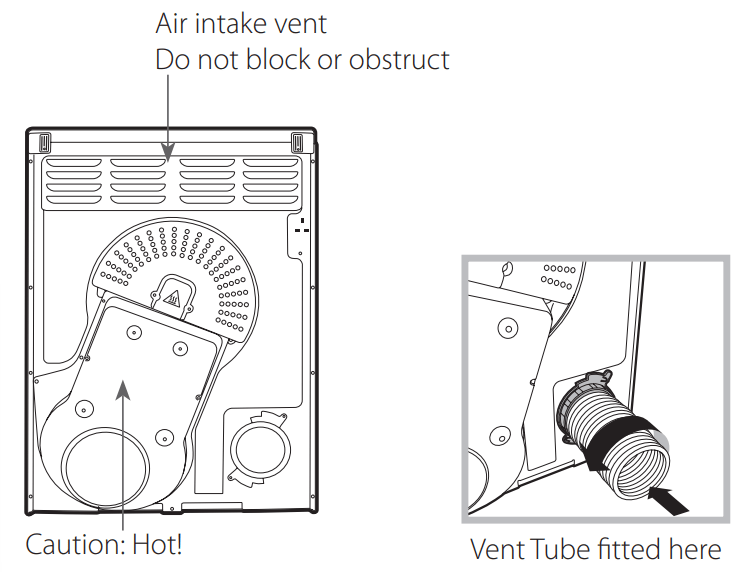

Window mounting The hole in the window should be as low down as possible and the tube should be kept as short as possible.Depending on how often you use your tumble dryer, it is essential that areas A and B are checked periodically to remove lint or debris.
Open window venting
The end of the tube should be directed downwards, to prevent warm moist air from condensing in the room or dryer.
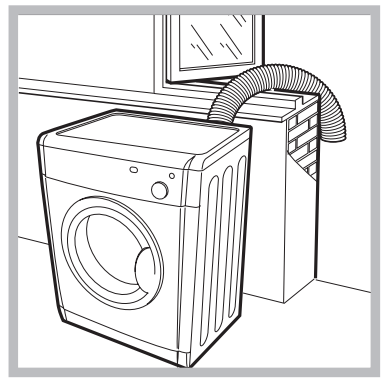
Do not discharge exhaust air into a flue which is used for exhaust fumes from other appliances that burn gas or other fuels.
Do not discharge exhaust air into an extraction system or any duct with an extractor fan. This will affect the way the thermal controls operate and can result in a fire hazard.
ELECTRICAL CONNECTIONS
The socket must be grounded. The power supply cord should be checked periodically. If the supply cord is damaged, it must be replaced by the manufacturer, its service agent or similarly qualified persons in order to avoid a hazard
LEVELLING YOUR DRYER

The dryer must be installed level for correct operation. When you have installed your dryer in its final location check that it is first level side to side and then back to front. If the dryer is not level use a wooden block to support it while adjusting the two front legs up or down until your dryer is level.
BEFORE YOU START USING YOUR DRYER
Once you have installed your dryer and before you use it clean the inside of the drum to remove any dust that could have accumulated during transport.
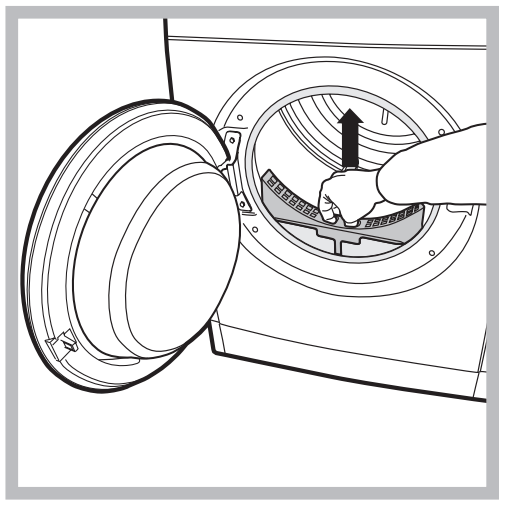
Step 1 Open the door of your dryer
Step 2 Pull out the filter (using the two finger grips)
Step 3 Clean the fluff off the filter and replace it correctly. Ensure that the filter is pushed fully home.
Step 4 Make sure the filter is pushed fully home NEVER run the dryer without the filter in position
Failure to clean the filter after EVERY drying cycle will affect the drying performance of your machine. It will take longer to dry and as a result will use more electricity during drying.
At least every two or three months you MUST clean fluff build up around the filter housing and the vent tube.
Check the vent tube and any permanent venting fixture to make sure that there has been no accumulation of fluff or lint. Remove lint that collects around the filter and the outlet vents.
Dryer Description

The HEAT button selects drying temperature.
OUT: LOW heat
IN: HIGH heat.
The TIMER knob: the 0 position swithes off the dryer.
The TIMER knob sets the drying time: rotate it clockwise, NEVER COUNTER-CLOCKWISE, until the indictor is pointing to the drying time you want to select.
CHOOSING A PROGRAMME
- Plug the dryer into the electrical socket.
- Sort your laundry according to fabric type.
- Open the door and make sure the filter is clean and in place.
- Load the machine and make sure items are not in the way of the door seal. Close door.
- Set the temperature with the HEAT button. High heat for Cotton and synthetics. Low heat for delicates and acrylics.
- Select a drying time by rotating the TIMER knob clockwise. The tables below show APPROXIMATE drying times in minutes. Weights refer to dry garment weights.
- Press the START button to begin. During the drying programme, you can check on your laundry and take out items that are dry while others continue drying. When you close the door again press the START button in order to resume drying.
- About 10 minutes before the programme is completed it enters the final COOL TUMBLE phase (fabrics are cooled) which should always be allowed to complete.
- Open the door, take the laundry out, clean the filter and replace it.
- Unplug the dryer.
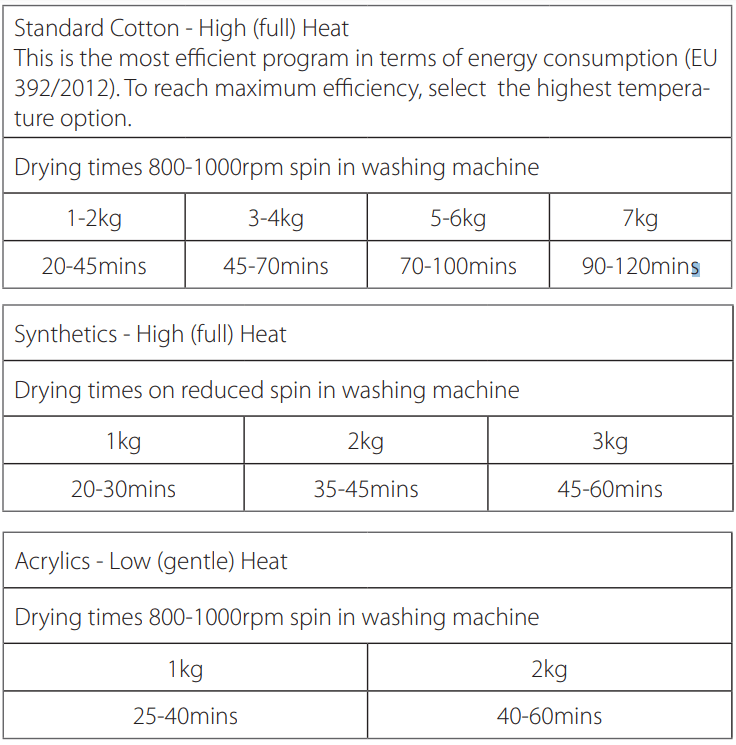
Laundry
Natural fibres: 7kg max
Synthetic fibre: 3kg max
WASH CARE LABELS
Look at the labels on your garments when tumble drying. The following symbols are the most common.
 May be tumble dried
May be tumble dried
 Do NOT tumble dry
Do NOT tumble dry
 Tumble dry at high heat setting
Tumble dry at high heat setting
 Tumble dry at low heat setting
Tumble dry at low heat setting
ITEMS NOT SUITABLE FOR TUMBLE DRYING
- Articles that contain rubber or rubber-like materials or plastic film, any flammable articles or objects that contain flammable substances.
- Glass fibres.
- Items which have been dry cleaned.
- Large bulky items (quilts, sleeping bags, etc). These expand when drying and prevent airflow through the dryer.
Troubleshooting
Before you call the service centre go through the following troubleshooting suggestions:
PROBLEM:
The dryer won’t start.
POSSIBLE CAUSES/SOLUTION:
- The plug is not in the socket or making contact.
- There has been a power failure.
- The fuse has blown. Try to plug another appliance into the socket.
- You are using an extension cord? Try to plug the dryer directly into the socket.
- The timer knob has not been set properly.
- The start button has not been pressed.
- The start button was pressed with the door open. Make sure the door is closed before pressing the start button.
PROBLEM:
- It is taking a long time to dry.
POSSIBLE CAUSES/SOLUTION:
- The filter has not been cleaned.
- The temperature setting is not correct.
- The correct time has not been selected.
- The vent tube or air intake vent is obstructed.
- The items were too wet.
- The dryer was over loaded.
Warnings
! This appliance has been designed and built according to international safety standards. These warnings are given for safety reasons and must be followed carefully.
GENERAL SAFETY
This appliance can be used by children aged from 8 years and above and persons with reduced physical, sensory or mental capabilities or lack of experience and knowledge if they have been given supervision or instruction concerning use of the appliance in a safe way and understand the hazards involved.
This tumble dryer has been designed for home, and not professional, use.
Do not touch the appliance while barefoot or with wet hands or feet.
Unplug the machine by pulling on the plug, not the cord.
Children should be supervised to ensure that they do not play with the dryer.
Cleaning and user maintenance shall not be made by children without supervision.
Children of less than 3 years should be kept away from the appliance unless continuously supervised.
The appliance must be installed correctly and have proper ventilation. The air intake vents behind the machine, the outlet vents and the vent tube should never be obstructed
Never direct the vent tube outlet towards the air intake at the back of the machine.
Never allow the tumble dryer to recycle exhaust air.
Never use the dryer on carpeting where the pile height would prevent air from entering the dryer from the base.
Check to see if the dryer is empty before loading it.
 The back of the dryer could become very hot. Never touch it while in use.
The back of the dryer could become very hot. Never touch it while in use.
Do not use the dryer unless the filter is securely in place
Do not overload the dryer
Do not load items that are dripping wet.
Carefully check all instructions on clothing labels
Do not tumble dry large, very bulky items.
Do not tumble dry acrylic fibres at high temperatures.
Do not turn off the dryer when there are still warm items inside.
Clean the filter after each use
Do not allow lint to collect around the dryer.
Never climb on top of the dryer. It could result in damage.
Always follow electrical standards and requirements
Always buy original spare parts and accessories
To minimise the risk of fire in your tumble dryer, the following should be observed:
Tumble dry items only if they have been washed with detergent and water, rinsed and been through the spin cycle. It is a fire hazard to dry items that HAVE NOT been washed with water.
Do not dry garments that have been treated with chemical products.
Do not tumble dry items that have been spotted or soaked with vegetable or cooking oils, this constitutes a fire hazard. Oil-affected items can ignite spontaneously,especially when exposed to heat sources such as a tumble dryer. The items become warm, causing an oxidisation reaction with the oil, Oxidisation creates heat. If the heat cannot escape, items can become hot enough to catch fire. Piling, stacking or storing oil-effected items can prevent heat from escaping and so create a fire hazard.If it is unavoidable that fabrics containing vegetable or cooking oil or those that have been contaminated with hair care products be placed in a tumble dryer they should first be washed with extra detergent - this will reduce, but not eliminate the hazard. They should not be removed from the dryer and piled or stacked while hot.
Do not tumble dry items that have previously been cleaned in or washed in, soaked in or soiled with petrol/gasoline, dry cleaning solvents or other flammable or explosive substances. Highly flammable substances commonly used in domestic environments including cooking oil, acetone, denatured alcohol, kerosene, spot removers, turpentine, waxes and wax removers. Ensure these items have been washed in hot water with an extra amount of detergent before being dried in the tumble dryer.
Do not tumble dry items containing foam rubber (also known as latex foam), or similarly textured rubber like materials. Foam rubber materials can, when heated, produce fire by spontaneous combustion.
Fabric softener or similar products should not be used in a tumble dryer to eliminate the effects of static electricity unless the practice is specifically recommended by the manufacturer of the fabric softener product.
Do not tumble dry undergarments that contain metal reinforcements eg. bras with metal reinforcing wires. Damage to the tumble dryer can result if the metal reinforcements come loose during drying.
Do not tumble dry rubber, plastic articles such as shower caps or babies waterproof covers, polythene or paper.
Do not tumble dry rubber backed articles, clothes fitted with foam rubber pads, pillows, galoshes and rubber coated tennis shoes.
Remove all objects from pockets such as lighters and matches.
WARNING: Never stop the dryer before the end of the drying cycle unless all items are quickly removed and spread out so that the heat is dissipated.
INFORMATION ON RECYCLING AND DISPOSAL 
- As part of our continual commitment towards environmental protection, we reserve the right to use recycled quality components to reduce costs for our customers and to minimise materials wastage.
- Disposing of the packaging materials: follow local regulations to allow for recycling of packaging materials.
- In order to minimise the risk of injury to children, remove the door and plug, then cut the power supply cord flush with the appliance. Dispose of these parts separately to prevent the appliance from being connected to a power supply socket.
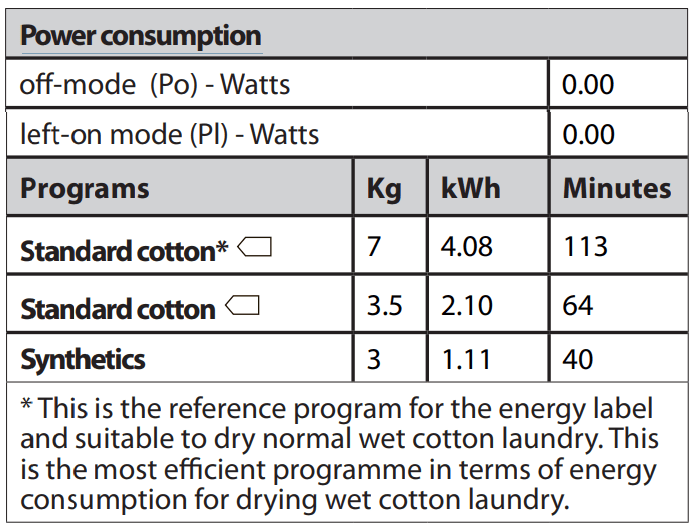
SAVE ENERGY AND RESPECT THE ENVIRONMENT
Wring out all items to eliminate excess water before tumble drying (if you use a washing machine first, select a high spin cycle). Doing this will save time and energy during drying.
Always dry full loads - you save energy: single items or small loads take longer to dry. Clean the filter after each use to contain energy consumption costs
OUR ADVISORS WILL REQUIRE THE FOLLOWING INFORMATION:
- name, address and postal code
- telephone number
- type of malfunction
- date of purchase
- model number
- serial number
- This information can be found on the data plate located behind the door.
See other models: NM11 744 WW A EU RD 966 JGD UK H8 A1E S SA2 540 H WH H7T 911T MX H
